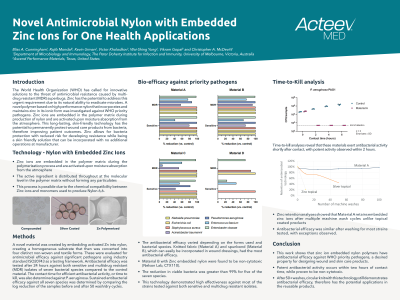Laboratory Research
(LR-034) Novel Antimicrobial Nylon with Embedded Zinc Ions for One Health Applications
Friday, April 28, 2023
7:15 PM - 8:30 PM East Coast USA Time

Bliss Cunningham, PhD – Postdoctoral Researcher, Department of Microbiology and Immunology, University of Melbourne; Kevin Urman, PhD – Ascend Performance Materials; Victor Kholodkov, MS; Wai-Shing Yung, PhD; Vikram Gopal, PhD – CTO, Technology, Ascend Performance Materials; Christopher McDevitt, PhD – Professor, Department of Microbiology and Immunology, University of Melbourne
Introduction: The World Health Organization (WHO) has called for innovative solutions to the threat of antimicrobial resistance caused by multi-drug resistant superbugs. Zinc has the potential to address this urgent requirement due to its natural ability to eradicate microbes. A novel polymer based on high performance nylon that incorporates and maintains zinc in its ionic form was investigated against WHO priority pathogens. Zinc ions are embedded in the polymer matrix during production of nylon and are activated upon moisture absorption from the atmosphere. This long-lasting, skin-friendly technology has the potential to permanently protect wound care products from bacteria, therefore improving patient outcomes.
Methods: A novel material was created by embedding activated Zn into nylon, creating a homogeneous substrate that then was converted into four distinct non-woven and textile forms. These were evaluated for antimicrobial efficacy against significant pathogens using industry standard ISO20743 as a testing framework. Antibacterial efficacy was tested after 24 hours against both sensitive and multidrug resistant (MDR) isolates of seven bacterial species compared to the control material. The contact time for efficient antibacterial activity, or time to kill, was also determined against P. aeruginosa. Sustained antibacterial efficacy against all seven species was determined by comparing the log reduction of the samples before and after 50 wash/dry cycles.
Results: Material A, circular knitted fabric, and Material B, spunbond non-woven, displayed the most antibacterial efficacy against all species tested. The reduction in viable bacteria was greater than 99% for five of the seven species. Time-to-kill analyses reveal that these materials exert antibacterial activity shortly after contact, with potent activity observed within 2 hours. Further, elemental analyses showed that embedded zinc ions are retained after multiple wash cycles.
Discussion: The antibacterial efficacy varied depending on the forms used and bacterial species. Knitted fabric and spunbond, which can easily be incorporated in wound dressings, had the most antibacterial efficacy. This technology demonstrated high effectiveness against most of the strains tested against both sensitive and multidrug resistant isolates. Collectively, this work shows that zinc ion embedded nylon technology has sustained antibacterial efficacy against WHO priority pathogens, a desired property for designing wound and skin care products.
Methods: A novel material was created by embedding activated Zn into nylon, creating a homogeneous substrate that then was converted into four distinct non-woven and textile forms. These were evaluated for antimicrobial efficacy against significant pathogens using industry standard ISO20743 as a testing framework. Antibacterial efficacy was tested after 24 hours against both sensitive and multidrug resistant (MDR) isolates of seven bacterial species compared to the control material. The contact time for efficient antibacterial activity, or time to kill, was also determined against P. aeruginosa. Sustained antibacterial efficacy against all seven species was determined by comparing the log reduction of the samples before and after 50 wash/dry cycles.
Results: Material A, circular knitted fabric, and Material B, spunbond non-woven, displayed the most antibacterial efficacy against all species tested. The reduction in viable bacteria was greater than 99% for five of the seven species. Time-to-kill analyses reveal that these materials exert antibacterial activity shortly after contact, with potent activity observed within 2 hours. Further, elemental analyses showed that embedded zinc ions are retained after multiple wash cycles.
Discussion: The antibacterial efficacy varied depending on the forms used and bacterial species. Knitted fabric and spunbond, which can easily be incorporated in wound dressings, had the most antibacterial efficacy. This technology demonstrated high effectiveness against most of the strains tested against both sensitive and multidrug resistant isolates. Collectively, this work shows that zinc ion embedded nylon technology has sustained antibacterial efficacy against WHO priority pathogens, a desired property for designing wound and skin care products.

.png)